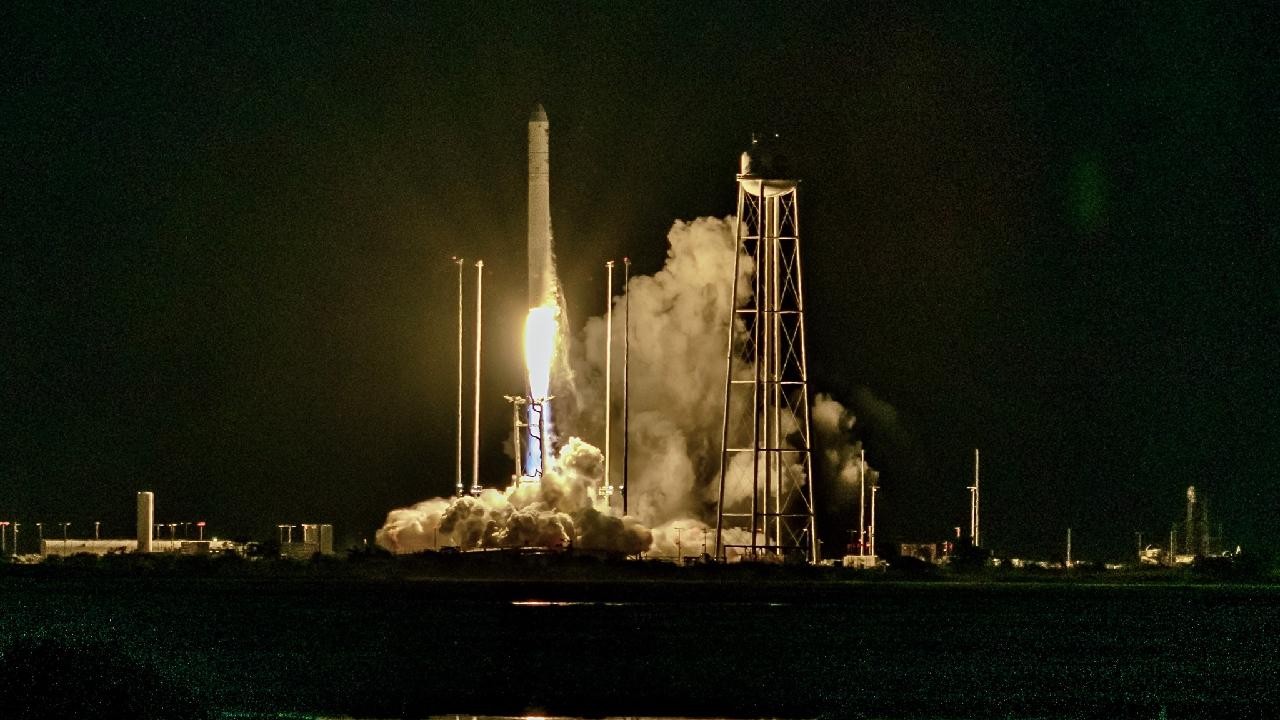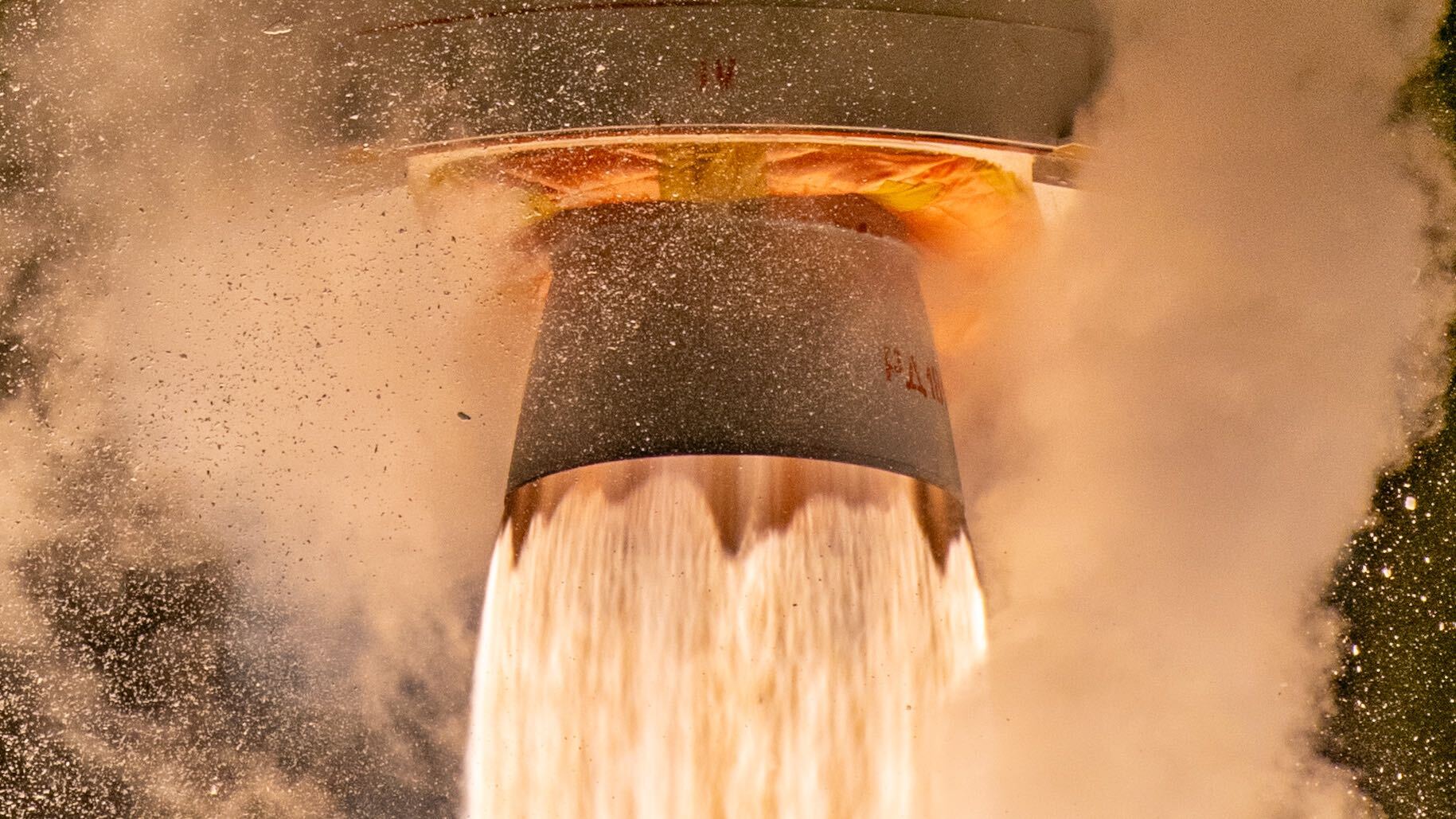Antares rocket makes its final launch, sending cargo to the International Space Station
This is the end of the Antares rocket as we know it.
An Antares rocket launched to the International Space Station Tuesday (Aug. 1), marking the final flight for this vehicle as we know it.
The 19th commercial resupply service mission from Northrop Grumman (NG-19) lifted off at 8:31 p.m. EDT (0031 GMT on Aug. 2) from NASA's Wallops Flight Facility carrying a batch of cargo, provisions and science experiments to the International Space Station (ISS). This is the final flight for this particular model of Antares rocket, which is set to be replaced with a newer version sometime next year.
Around 8 minutes into the flight, a Cygnus spacecraft separated from Antares' second stage containing over 8,200 pounds (3,700 kilograms) of cargo for the current ISS crew. That spacecraft is set to arrive at the ISS on Friday (Aug. 4) at 5:54 a.m (0954 GMT). You can watch the docking live here beginning at 4:30 a.m. ET (0930 GMT) courtesy of NASA TV.
Related: Northrop Grumman's Private Antares Rocket: 5 Surprising Facts
Continuing their tradition of naming Cygnus vehicles for influential individuals in spaceflight, the NG-19 Cygnus was christened the SS Laurel Clark, for the fallen space shuttle Columbia astronaut. Once on orbit, the SS Laurel Clark will spend about 2.5 days catching up to the ISS.
Tonight's launch marks the last for the current version of Northrop Grumman's Antares rocket, the Antares 230 series. Supply lines for Antares, which relied on Ukrainian-built first stages and Russian rocket engines, were disrupted at the beginning of Russia's invasion of Ukraine in February, 2022.
In response, Northrop Grumman announced an agreement with U.S. company Firefly Aerospace to manufacture engines and a new first stage for an upgraded Antares 330 series rocket, which was expected to launch in the latter half of next year. However, in a pre-launch press conference July 30, Northrop Grumman director of space launch programs Kurt Eberly indicated the company has had reassess that timeline.
Breaking space news, the latest updates on rocket launches, skywatching events and more!
Eberly says Northrop Grumman was, "hoping for the end of '24," but that expectation has shifted. According to Eberly, the upgraded Antares, "is going to feature a new first stage and the existing upper stack that'll get us back flying in the Summer 2025." Antares 330's first launch will be the NG-23 mission.
Aboard, the SS Laurel Clark will carry more than 20 research investigations, equipment and foodstuffs to replenish supplies for the space station's current and upcoming crews. The ISS National Laboratory, which manages public research on the space station, has sponsored more than 20 experiments flying on NG-19.
Research headed to the ISS includes several material science and technology demonstrations to test Earth-monitoring sensors, space antenna upgrades and material science investigations, as well as nearly half a dozen human health-focused biological investigations. These will study therapies for cardiovascular regenerative techniques, neurological and genetic disorders and degenerative retinal diseases. A full list of highlights is available on the ISS National Lab website.
NASA published its own list of notable research aboard NG-19, which includes the sixth and final flammability experiment from NASA's Glenn Research Center. Saffire-VI is a part of a series of demonstrations with the goal of understanding how fire behaves in space. The automated experiment won't take place until near the end of the NG-19 mission, after the Cygnus spacecraft has undocked from the ISS and entered an independent orbit. There, Saffire-VI will initiate a sequence of burns at differing oxygen levels, which scientists will observe remotely.
"This work has already changed our understanding of material flammability in low gravity and demonstrated that just as on Earth, smoke from a fire represents the most immediate hazard to the crew," Saffire principal investigator David Urban said in a NASA release.
A new planetary observation probe is headed to the ISS is called the Multi Needle Langmuir Probe (m-NLP). This sensor, from the European Space Agency (ESA), will be attached to the exterior of the station, on the Columbus module's Bartolomeo Platform. The m-NLP features six pointy, protruding probe antenna used to scan plasma densities in Earth's ionosphere, which have deleterious affects on GPS and other satellite-based navigation systems.
Another piece of hardware aboard the SS Laurel Clark is a new potable water dispenser (PWD). Dubbed Exploration PWD, the station's new drinking fountain is replacing one that launched in 2008. Exploration PWD can be operated remotely, and features a host of other upgrades compared to its predecessor. It has the ability to self-monitor the status of its various systems, uses "advanced water sanitization and microbial growth reduction methods," according to the NASA statement, and is capable of dispensing hot water.
The Japan Aerospace Exploration Agency (JAXA) as has cargo flying as part of the NG-19 mission. As part of an educational outreach program, JAXA has included a hard drive containing digital artwork from over 13,000 students across 74 schools. A similar mission, the STORIES of Space Project (Story SD Card Testing and On-Board Research on the International Space Station Experiment and Survey), will deliver more than 300 written stories stored on SD-cards, with the goal of engaging space enthusiasts with space exploration. STORIES will also measure the effects of memory degradation due to the effects of radiation on those SD-cards.
In a statement, STORIES of Space Project creator Beth Mund said, "the STORIES of Space project engages a growing community of space exploration ambassadors – people who may never train to be an astronaut or travel to space, but space enthusiasts who want to be a part of the discovery and advancements in space."
NASA coverage for Cygnus' rendezvous with the ISS will begin at 4:30 a.m. EDT (0830 GMT), Friday, August 4. Using the space station's robot arm, NASA astronaut Woody Hoburg will capture Cygnus for berthing at the Unity module's nadir (Earth-facing) port, around 7:30 a.m. EDT (1130 GMT). Cygnus will remain at the station until October, after which it will be loaded with station refuse and released for repositioning into a decaying orbit, where it will eventually burn up in Earth's atmosphere.
With the Antares 300 series not yet operational, Northrop Grumman has contracted SpaceX to fly the next few Cygnus cargo spacecraft aboard a Falcon 9 rocket. Grumman's twentieth resupply mission, NG-20, is slated for sometime this November.

Josh Dinner is the Staff Writer for Spaceflight at Space.com. He is a writer and photographer with a passion for science and space exploration, and has been working the space beat since 2016. Josh has covered the evolution of NASA's commercial spaceflight partnerships and crewed missions from the Space Coast, as well as NASA science missions and more. He also enjoys building 1:144-scale model rockets and human-flown spacecraft. Find some of Josh's launch photography on Instagram and his website, and follow him on X, where he mostly posts in haiku.


